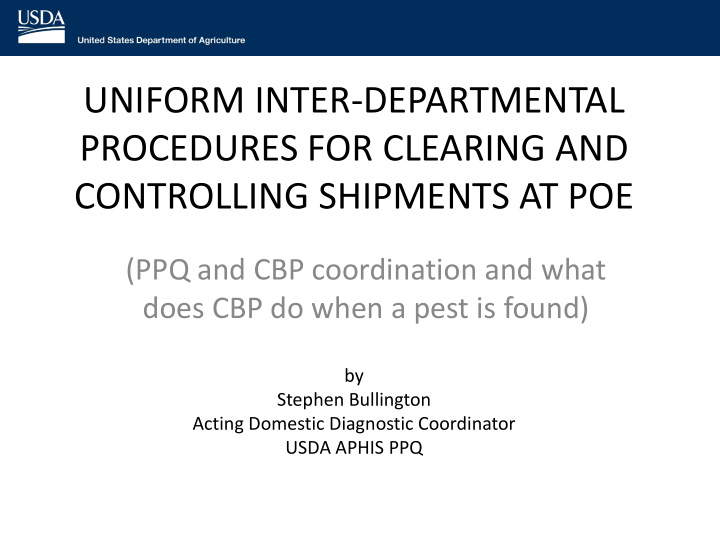



UNIFORM INTER-DEPARTMENTAL PROCEDURES FOR CLEARING AND CONTROLLING SHIPMENTS AT POE (PPQ and CBP coordination and what does CBP do when a pest is found) by Stephen Bullington Acting Domestic Diagnostic Coordinator USDA APHIS PPQ
KEEP IN MIND 1. Even though specific actions that follow may take place away from the port, they are all integral to clearing and controlling shipments there 2. These actions involve coordinating a variety of actors—CBP, PPQ Port Operations, the SEL, NIS, and occasionally CPHST 3. Taken as a whole, these actions are preemptive— cargo infested with exotic pests is never allowed to enter commerce 4. This described routine is uniform—it is followed by 80+ Area Identifiers at over 327 official ports and 16 Plant Inspection Stations
WITH CBP 1. Cargo inspected by CBP 2. If potential pest found, CBP puts hold on cargo 3. Potential pest specimen submitted to PPQ Area (Port) Identifier
WITH AREA IDENTIFIER 1. Area Identifier issues 309 for specimen in Pest ID; this 309 contains all of the relevant information for the interception—date, number of specimens and life stages of the potential pest, country of origin, inspected host, etc. 2. Then puts most unambiguous name on specimen he/she can--ideally a species name
WITH AREA IDENTIFIER 1. If ID is to species and he/she has authority for that species, that ID is final 2. In Pest ID each taxon (family, genus, or species) name is considered as either “Reportable” or “Non-Reportable”
“PEST” STATUS--1 1. NON-REPORTABLE—This means that we can release the hold on the cargo and let it enter commerce, as the organism is either NOT a pest, or is a pest that is native or already established Remember, PPQ is tasked with keeping out exotic pests, i.e. those that are not found here— we have no legal mandate to insure that commodities are free of native or established pests
“PEST” STATUS--2 1. REPORTABLE—This means we need to look closer at the specimen and the situation in which it was intercepted, before we can arrive at a quarantine decision For a Reportable taxon two quarantine decisions are possible: 1. ACTION—Mitigation of some type is mandatory 2. NO ACTION—the shipment is treated as if the interception was Non-Reportable
WITH AREA IDENTIFIER 1. If Area Identifier has authority for an ID, they then decide course of action and update 309 with it. Options for “Action” include: Treatment Destruction Return FRSMP Pest 2. If ID is to family or genus, or identifier does not have authority for that species, it is preliminary, and the specimen is submitted to appropriate National Specialist for a final ID. In other words, the 309 becomes an “Urgent”
A WORD ON PRIORITY (and some other terms) 1. URGENT—cargo on hold awaiting ID; turn- around time within 24 hours 2. PROMPT—important for some other reason; turn-around time a few weeks 3. ROUTINE—can ID at leisure 4. DIGITAL—special Urgent where photos are sent instead of specimen
WITH NATIONAL SPECIALIST 1. National Specialists located at several places: at SEL (Entomology) in either Beltsville or at the Smithsonian, or with NIS in Beltsville (Entomology, Botany, Mycology), or with NIS in Philadelphia (Malacology) 2. National Specialist identifies specimen 3. Adds ID to 309 record in Pest ID Database
AT NIS HEADQUARTERS 1. Updated Urgent 309s automatically sent to NIS; we get 50-100/day 2. NIS personnel decide course of action and then note that on 309 Treatment Destruction Return FRSMP Pest Release 3. NIS notifies Area Identifier of selected action by FAX
WITH CBP AGAIN 1. Area Identifier notifies CBP of final ID and NIS recommendation 2. CBP complies with recommendation 3. EAN issued if cargo not released
SUMMARY • Inspections are ALWAYS responsibility of CBP • In some cases both Final ID of potential pest and Quarantine Decision are responsibility of PPQ Area Identifier • In other cases Final ID responsibility of National Identifier and Quarantine Decision are responsibility of NIS • Compliance with and implementation of Quarantine Decision are ALWAYS responsibility of CBP
QUESTIONS?
Recommend
More recommend